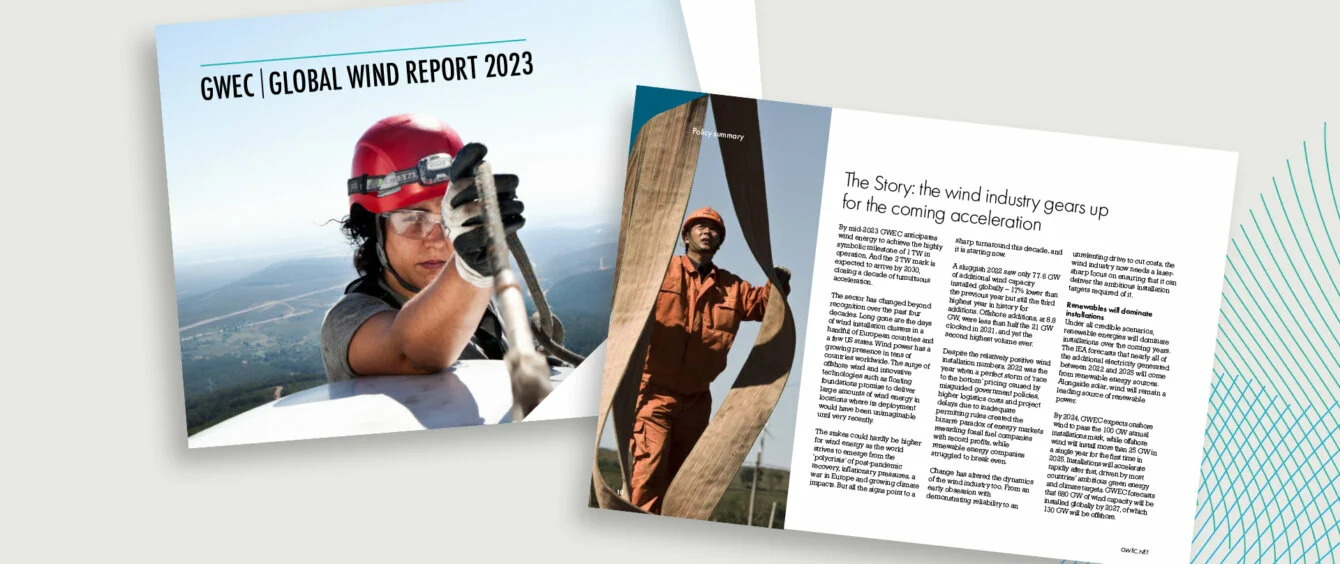The Global Wind Energy Council (GWEC) has published its Global Wind Report 2023, providing an insight into the achievements of and challenges faced by the wind industry.
77.6 GW of new wind capacity was installed in 2022, according to GWEC, the third highest level ever, following records in 2020 and 2021, bringing total capacity installed worldwide to 906 GW, an increase of 9% year on year.
New installations were split 68.8 GW onshore and 8.8 GW offshore.
In the onshore market, China accounted for 52% of the new capacity, while Europe saw a record year with 16.7 GW of new installations, driven in particular by buoyant markets in Sweden, Finland and Poland. This gave the region overall a market share of 24%.
However, there was a slowdown in activity in Latin America, the Middle East and North America. The US commissioned only 8.6 GW of new onshore wind in 2022, owing to supply chain constraints and interconnection issues, the report says.
For the offshore market, 2022 saw the second highest level of new installations, following the record year of 2021. China installed 5 GW of offshore wind, while Taiwan completed 1,175 MW and Japan 84 MW, indicating the emergence of broad growth across multiple markets in Asia.
Similarly, in Europe, which accounted for the remaining 2.5 GW of capacity, Italy and France each commissioned their first commercial-scale offshore wind farms.
Outlook for expansion very positive
While 2022 may not have broken many records, the outlook for wind in this year is very positive. Both climate change and energy security concerns have placed wind centre stage in energy strategies worldwide as an affordable, domestic generator of sustainable energy.
GWEC estimates that new wind installations this year could exceed 100 GW for the first time and that 680 GW could be installed over the next five years. This breaks down as average annual new installations of 110 GW for onshore wind and 26 GW/yr for offshore wind.
GWEC’s new forecast for 2023-2030 is 143 GW higher than its outlook published last year, but it warns this will still only deliver 68% of the new capacity required by 2030 to keep the rise in global temperatures to 1.5°C above pre-industrial levels.
Growing pains
The expansion of the wind industry over the last four decades has been extraordinary, but full of challenges. Today, it is unquestionably a global industry with its footprint reaching into an ever larger number of countries.
Alongside solar, wind power has become the backbone of the energy transition, but it needs to grow even faster than it already has, GWEC says.
This requires a massive expansion of the supply chains which support wind power installations. It took 40 years to build the first TW of capacity (a milestone expected to be passed by the middle of this year) and the next TW will be built in just 7 years.
This will absorb all spare capacity in the industry by 2026, GWEC estimates.
Without new supply chain investment, the report predicts bottlenecks in nacelle construction, gearbox manufacturing, as well in key components such as blades and generators. The report highlights a risk of supply chain shortfalls in the US and European wind markets. In particular, GWEC warns against the use of prescriptive localization requirements and restrictive trade practices, which, it says, could result in price increases and limit the expansion of supply chains.
Exciting markets to watch
Brazil comes top of GWEC’s ‘markets to watch’ list, owing to the country’s established onshore wind sector and rising interest in offshore wind, where the potential is enormous. A new government, which came to power in January, has promised to put renewables and climate change at the top of its agenda, while offshore wind enthusiast Jean Paul Prates has been appointed head of the country’s state-owned energy company Petrobras.
India also promises a dynamic wind market, driven by rapid rates of electricity demand growth over the next decade, according to GWEC. It appears to be on the cusp of a dive into offshore wind and recent policy reforms are expected to accelerate new onshore wind additions in coming years.
Meanwhile, following a period of limited additions, Egypt has announced GW-scale projects, which, if realized, would “propel the country’s wind energy industry into the upper echelon of emerging markets worldwide,” GWEC says. Central to this ambition is a plan for a separate electricity grid backed by two 10 GW onshore wind farms, which would boost hugely renewables’ share of the country’s electricity market.
Overall, GWEC says, the wind industry is entering a new period of expansion, geographically and industrially, one which is crucial to energy security and climate goals. However, to do so, it requires direct support to build the capacity necessary for successful delivery.
